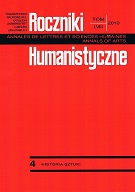Metafory ciała: głowa-twarz na wybranych przykładach malarstwa Duccia i Giotta
The Head-Face Body Metaphors in Selected Paintinings by Duccio and Giotto
Author(s): Małgorzata Urszula MazurczakSubject(s): Cultural history
Published by: Towarzystwo Naukowe KUL & Katolicki Uniwersytet Lubelski Jana Pawła II
Keywords: body and carnality; feelings and emotions; sensations; physiognomy; ciało; cielesność; uczucia; wrażenia; fizjonomia
Summary/Abstract: The body and carnality in art, especially in the Middle Ages, have been researched widely over the past decade. The list includes, among others, such seminal works as those by V. Dasen, J. Wilgaux, N. Laneyrie-Dagen, G. Didi-Huberman, J. J. Courtine, C. Haroche. Also, the author of this paper has published on the topic. As a research problem, the body is not limited to the issue of nakedness. Neither is it reducible to the question of the general conception of painting the body – whether human or divine, and whether it matches the classical conception (that assumes some ideal reproduction of the body, in harmony with proportions and with the human nature) or not. Medieval art betrays deliberate deformations from the classical canon. Some of them have been named styles, when an artist was said to have purposefully transgressed the classical conception. Other distortions have been pronounced failures to properly artistically reconstruct the human body, due to the lack of proper education in Antique classical art. The way in which the body is reconstructed artistically implies its role in the composition as a whole, including the relation between the painted figure to the other people presented in the painting (accompanying persons or random witnesses of a scene). It was the logic of the content that dictated the fashion in which divine and human figures were presented. This convention was also of use in presenting the head-face element as the most important body part. It was the head and the face where the content and the symbolic message, along with all body-related metaphors, were cumulated. The off-side figures and the passers-by were depicted in their individual, natural portrayals and were not bound by the artistic or dogmatic convention or message. These variations in the way in which the head-face element was artistically reconstructed in paintings are discussed and illustrated with the use of a selection of works by Duccio and Giotto.
Journal: Roczniki Humanistyczne
- Issue Year: 58/2010
- Issue No: 04
- Page Range: 59-86
- Page Count: 28
- Language: Polish

